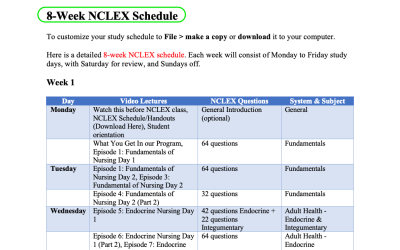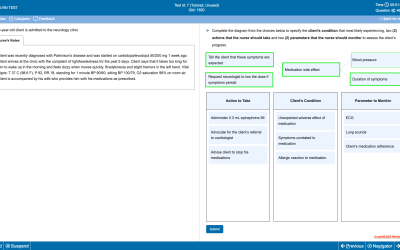Mastering the NCLEX®: A Detailed Guide for Success
The NCLEX® (National Council Licensure Examination) is one of the last hurdles you need to clear on your journey toward becoming a registered nurse. It’s a comprehensive exam designed to test not just your knowledge, but your ability to think critically and make sound decisions as a nurse. Most candidates agree that the NCLEX® is the toughest exam they’ve ever faced, but with the right strategy, you can conquer it with confidence.
In this blog, I will break down the process of answering NCLEX® questions effectively using a structured 4-step approach. By following these steps, you can master even the most challenging questions and avoid common pitfalls.
Step 1: Assess the Question
The first step in tackling any NCLEX® question is to assess the stem (the part of the question that provides context). This involves determining whether the question is asking for something positive or negative.
- A positive stem asks what is true or what should be done, while a negative stem asks for what is false or what should not be done.
- Look for keywords in the stem such as “appropriate,” “indicated,” “true,” “best,” and “most” for positive stems, or “not,” “avoid,” “contraindicated,” and “least” for negative stems.
Example: The question stem asks: “Which of the following actions by the nurse is appropriate?” This is a positive stem, meaning you are looking for the correct or best answer. On the other hand, if it asks, “Which action indicates further teaching is needed?” this is a negative stem, where you should look for something incorrect.
Step 2: Consider Priority
After assessing whether the stem is positive or negative, the next step is to focus on priority indicators. NCLEX® questions often ask you to prioritize your actions based on urgency or importance.
- Keywords like “first,” “most important,” “initial,” “immediate,” and “priority” signal that the question is asking for your first or most critical action.
- To determine the correct priority, use frameworks like the Nursing Process (ADPIE) and ABCs (Airway, Breathing, Circulation).
The Nursing Process is a systematic approach nurses use in patient care and includes the following steps:
- Assessment: Gather information and data about the patient.
- Diagnosis/Analysis: Interpret the data and identify patient problems.
- Planning: Develop a strategy to address the diagnosis.
- Implementation: Carry out the interventions.
- Evaluation: Assess the effectiveness of the interventions.
Remember: You must assess before you act. This is a common principle in NCLEX® questions, where performing a thorough assessment is often the priority before taking any action.
Example: The patient has sudden difficulty breathing. The question asks: “What should the nurse do first?” The correct response would be something related to assessing the airway before implementing any interventions like administering medications.
Step 3: Reword the Question
Once you’ve assessed the stem and considered priority, the next step is to reword the question. This simplifies the question and helps you focus on the core issue.
- After reading the question, condense it into a single, clear sentence that captures the essence of what is being asked. This can help avoid distractions from unnecessary details.
- Focus on the key action or issue in the question. By rephrasing, you ensure that you’re addressing the most important aspect of the patient’s situation.
Example: Let’s say the original question is: “The nurse is caring for a patient with congestive heart failure who is experiencing shortness of breath and swelling in the legs. The patient has not been compliant with their medication regimen. What is the nurse’s priority action?”
You can reword it to: “What should the nurse do first to address the patient’s worsening symptoms?” This simplifies the question to its core: addressing the patient’s immediate symptoms.
Step 4: Evaluate the Answer Choices
Now that you’ve assessed the question, considered priority, and reworded the question, it’s time to evaluate the answer choices. Here’s how to systematically eliminate wrong answers and select the correct one:
A. Eliminate incorrect choices.
- Identify distractors: NCLEX® questions are designed with distractors—answers that seem plausible but are incorrect.
- Eliminate choices that don’t match the scenario described in the question. If a choice has nothing to do with the patient’s condition or the key issue, it’s likely a distractor.
B. Look for repetition.
- Sometimes, multiple answers say the same thing in different words. If two or more answers are repetitive, they can often be eliminated, leaving you with the best option.
C. Promote safety.
- Patient safety is always the top priority. Use the ABCs (Airway, Breathing, Circulation) to determine which answer best ensures patient safety.
D. Consider opposites.
- If two answers are opposites, one is often correct. Use this strategy to narrow down your options.
E. Avoid absolutes.
- Answers that contain words like “always,” “never,” “only,” or “all” are often incorrect because there are few absolutes in nursing practice.
F. Stay by the book.
- The NCLEX® tests theoretical knowledge, so always choose answers that follow textbook procedures rather than shortcuts used in clinical practice.
G. Avoid “call the physician.”
- While calling the physician is a valid action in some cases, NCLEX® questions often require the nurse to take action before contacting the physician. Always assess and implement nursing actions first if possible.
Putting It All Together: Practice Questions
Let’s apply these steps to three sample NCLEX® questions using tables.
Example 1: Diabetic Ketoacidosis (DKA)
| Step | Details |
|---|---|
| Stem | A patient with type 1 diabetes is admitted with a blood glucose level of 580 mg/dL. The patient is complaining of nausea and has fruity-smelling breath. What is the nurse’s priority intervention? |
| Step 1: Assess | Positive stem: “What is the nurse’s priority intervention?” |
| Step 2: Consider Priority | The word “priority” indicates this is a critical action question. Apply the ABCs and consider what should be done first in DKA (life-threatening). |
| Step 3: Reword | What’s the first step in treating DKA? |
| Step 4: Evaluate | A) Administer insulin B) Give oral fluids C) Check urine for ketones D) Administer IV fluids |
| Correct Answer | D) Administer IV fluids – Fluid resuscitation is the first step in managing DKA, as it corrects dehydration and stabilizes circulation. |
Example 2: Postpartum Hemorrhage
| Step | Details |
|---|---|
| Stem | A postpartum patient has saturated two perineal pads in 30 minutes. What should the nurse do first? |
| Step 1: Assess | Positive stem: “What should the nurse do first?” |
| Step 2: Consider Priority | “First” signals a priority question. Use the Nursing Process (ADPIE) to determine whether the nurse should assess or act. |
| Step 3: Reword | What’s the first thing the nurse should assess or do for postpartum bleeding? |
| Step 4: Evaluate | A) Massage the fundus B) Call the physician C) Check the patient’s blood pressure D) Administer IV oxytocin |
| Correct Answer | A) Massage the fundus – Massaging the fundus stimulates uterine contractions, which helps stop bleeding and is the first intervention in hemorrhage. |
Example 3: Acute Coronary Syndrome (ACS)
| Step | Details |
|---|---|
| Stem | A patient with chest pain is being evaluated for acute coronary syndrome (ACS). The nurse notes an elevated troponin level. What is the nurse’s priority action? |
| Step 1: Assess | Positive stem: “What is the nurse’s priority action?” |
| Step 2: Consider Priority | “Priority” signals that the nurse must take immediate action. Use ABCs and consider what should be done first in ACS. |
| Step 3: Reword | What’s the first action for a patient with elevated troponin and chest pain? |
| Step 4: Evaluate | A) Prepare the patient for an ECG B) Administer nitroglycerin C) Draw additional blood for labs D) Place the patient on bed rest |
| Correct Answer | B) Administer nitroglycerin – Nitroglycerin reduces chest pain and improves blood flow to the heart, making it the priority intervention in ACS. |

When tackling NCLEX® questions, it’s important to have a solid strategy to ensure you’re choosing the right answers. Here’s a simple yet effective four-step method that will set your mind on F.I.R.E. 🔥:
F.I.R.E. stands for:
- F: Focus on the question.
- I: Identify priority indicators.
- R: Reword the question.
- E: Evaluate the answer choices.
Now, let’s see how the F.I.R.E. Method can be applied to an NCLEX® question.
Case Study Question:
A 21-year-old female presents to the emergency department with severe abdominal pain and light vaginal bleeding. She reports nausea, fatigue, and urinary frequency. Her last menstrual period was 8 weeks ago, and she denies pregnancy, stating that she has an intrauterine device (IUD) for birth control. She has a history of irritable bowel syndrome (IBS). Her pain began 2 hours ago and has worsened despite taking ibuprofen. The client appears tearful, diaphoretic, and pale.
Vital Signs:
| Vital Signs | 0100 | 0115 |
|---|---|---|
| BP | 96/64 | 94/62 |
| HR | 114 | 115 |
| RR | 24 | 24 |
| Temp | 99°F (37.2°C) | Not provided |
| SpO2 | 96% on room air | 96% on room air |
| Pain | 10/10 | 10/10 |
Question:
Which 4 findings require immediate follow-up?
- □ Blood pressure
- □ Nausea
- □ Pain
- □ Heart rate
- □ Urinary frequency
- □ Pale skin
- □ Diarrhea
- □ Headache
Answer Breakdown Using the F.I.R.E. Method
Step 1: Focus on the Question (F)
The question asks which four findings require immediate follow-up. This is a positive question, asking what needs attention right now. The client has several symptoms, but you need to focus on the critical ones that indicate deterioration.
Step 2: Identify Priority Indicators (I)
Look for the indicators that suggest an urgent situation. Vital signs trending towards hypovolemic shock are a red flag. Focus on findings that align with life-threatening conditions like shock, severe blood loss, or organ dysfunction.
- Low blood pressure: Trending downward, indicating potential shock.
- Elevated heart rate: Likely compensating for the low blood pressure.
- Severe pain: Persistent 10/10 pain is a sign of significant distress.
- Pale skin: Suggests poor perfusion, likely due to blood loss.
Step 3: Reword the Question (R)
Rephrase the question to make it clearer:
Which four findings indicate that the patient’s condition is worsening and needs immediate attention?
This simplified version helps you focus on the most important aspects of the patient’s condition, such as vital signs and symptoms of shock.
Step 4: Evaluate the Answer Choices (E)
Now, let’s go through each answer choice systematically:
- Blood pressure: It’s dropping, which is a strong sign of hypovolemia or shock. Needs immediate attention.
- Nausea: A discomforting symptom but not life-threatening.
- Pain: The patient’s pain is at a 10/10 despite medication. Needs immediate attention.
- Heart rate: Elevated, suggesting the body is compensating for falling blood pressure. Needs immediate attention.
- Urinary frequency: Not a critical finding in this context.
- Pale skin: A sign of poor circulation or blood loss. Needs immediate attention.
- Diarrhea: Could be related to IBS, but is not a priority here.
- Headache: Not the most critical concern in this case.
Final Answer:
The four findings that require immediate follow-up are:
- Blood pressure
- Pain
- Heart rate
- Pale skin
These findings point to the possibility of hypovolemic shock, which requires urgent medical intervention.
Conclusion
Using the F.I.R.E. Method—Focus, Identify, Reword, and Evaluate—you can break down complex NCLEX® questions into manageable steps. This method allows you to systematically approach each question, ensuring you catch priority findings and choose the best answer. So, when in doubt, set your mind on F.I.R.E. and tackle those NCLEX® questions with confidence!




